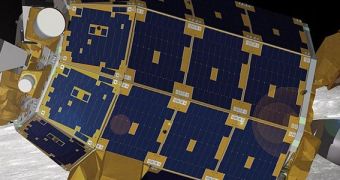Officials with the American space agency announced on Thursday, April 3, that the Lunar Atmosphere and Dust Environment Explorer (LADEE) spacecraft is currently being lowered in its orbit around the Moon, in anticipation of a crash into the lunar surface, scheduled for April 21. The spacecraft had a primary science mission duration of 100 days, to which another 28 days were already added.
Now that the extended science mission is coming to a close as well, NASA experts are getting ready to deorbit the spacecraft. In preparation for this event, LADEE's orbit is currently being lowered more and more, though the probe continues to make scientific observations of the lunar surface. In fact, NASA says, the spacecraft will continue to do so up to the moment of impact.
One of the objectives mission controllers at the NASA Ames Research Center (ARC) in Moffett Field, California, want to achieve before the mission ends is to conduct science measurements of the lunar surface from the lowest altitudes possible. For this purpose, they are currently maneuvering the probe into an orbit some 2 to 3 kilometers (1 to 2 miles) above the lunar surface.
This type of orbital ballet is extremely complex, and the smallest error can mean the difference between remaining in orbit and crashing. This is why ARC ground controllers are not targeting a specific location for impacting LADEE into; their only plan is to have the probe crash on the far side of the Moon, well beyond any other locations that have been visited or studied by humans.
“The Moon's gravity field is so lumpy, and the terrain is so highly variable with crater ridges and valleys that frequent maneuvers are required or the LADEE spacecraft will impact the Moon’s surface,” explains ARC research scientist, Butler Hine.
“Even if we perform all maneuvers perfectly, there's still a chance LADEE could impact the moon sometime before April 21, which is when we expect LADEE's orbit to naturally decay after using all the fuel onboard,” adds Hine, the manager of the LADEE project at the Ames Research Center.
The final orbital maintenance maneuver is currently scheduled to occur on April 11, beyond which time LADEE's orbit will be allowed to decay on its own. It is entirely possible that the probe will be lost on March 15, when an eclipse will project Earth's shadow over the Moon. This will create an extremely cold environment for the probe, pushing its resilience to the limits.
“If LADEE survives the eclipse, we will have nearly a week of additional science at low altitudes before impact. For a short mission like LADEE, even a few days count for a lot – this is a very exciting time in the mission,” adds ARC LADEE project scientist Rick Elphic.
The LADEE spacecraft was launched from the Mid-Atlantic Regional Spaceport (MARS), aboard a Minotaur V delivery system, on September 7, 2013. The probe achieved orbital insertion around the Moon on October 6, 2013, and began its science mission about a month later.

 14 DAY TRIAL //
14 DAY TRIAL //